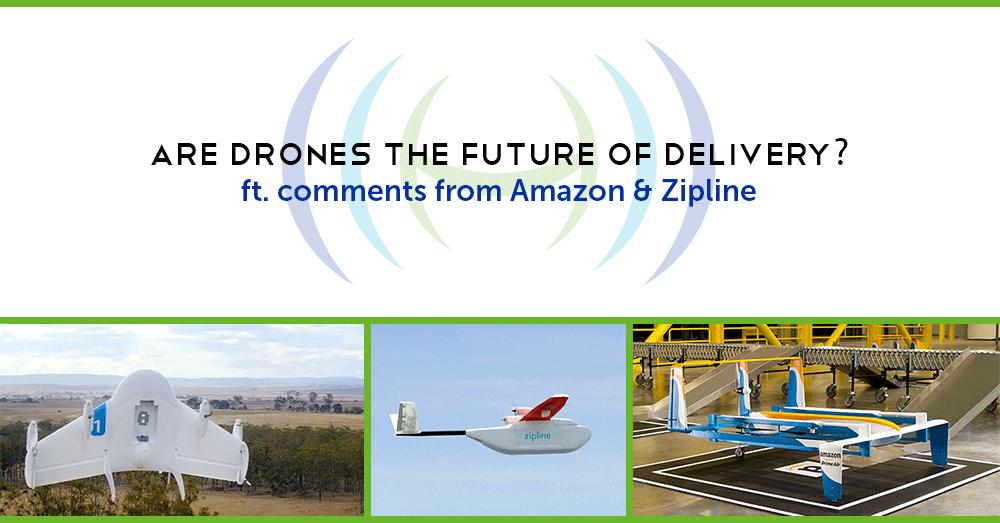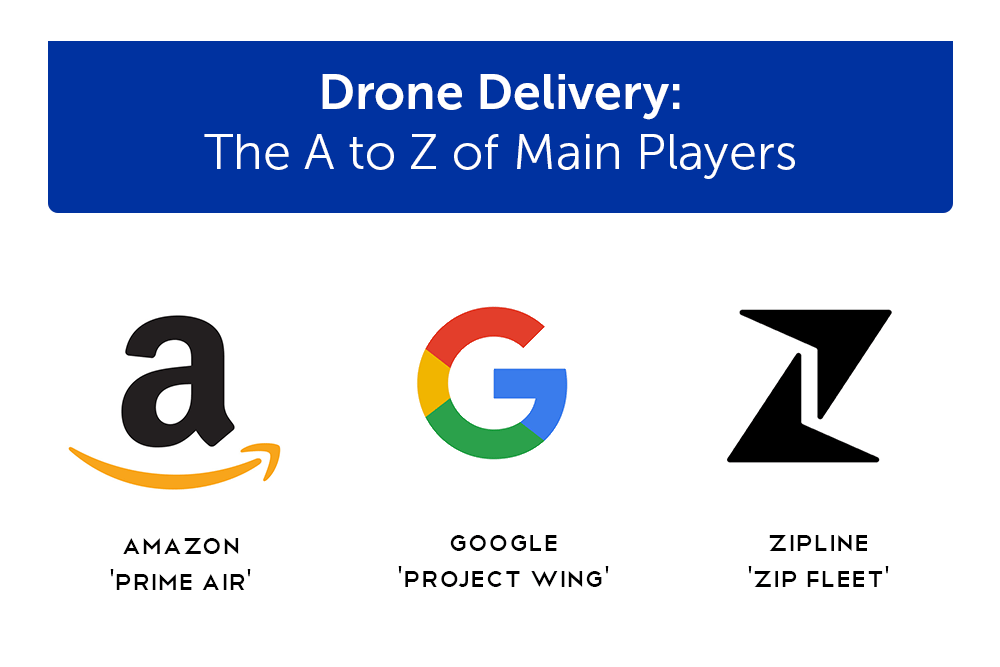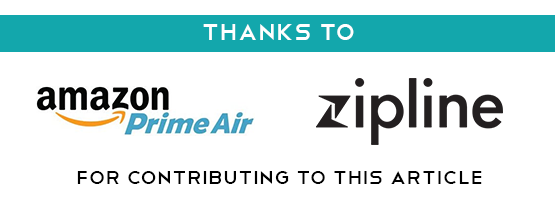
News
Are Drones the Future of Delivery?
The idea of drones deliveries has captured the public's imagination in recent months. We investigate this exciting prospect with input from Amazon & Zipline. ... Read More

Background
It’s possible to argue that drones have been used for delivery since their invention, as a means to transport images, footage and a wide range of data. Already replacing the pricier option of manned helicopters on film sets, farms and offshore rigs – the range of compatible sensors have turned drones into valuable tools for both commercial and industrial enterprise.
Drone sensors go thermal, check out the DJI Zenmuse XT
However, the public’s first inclination that drones were a viable method for conveying physical goods came when, in 2013, Amazon’s CEO Jeff Bezos announced plans to push for half-hour delivery slots via a cargo network of drones by 2017. While there were undoubtedly others looking into this possibility, Bezos’ announcement kick-started the race to roll-out commercial drone delivery services. The most recent announcement has come from Google (or more specifically their parent company ‘Alphabet’) who are beginning tests of ‘Project Wing’ in the US as of this month. With ‘Prime Air’ getting the green light for tests in Cambridgeshire and numerous start-ups clamouring to enter this revolution on the ground floor you can expect swift progress towards a viable unmanned delivery fleet. Of course, the success of these schemes depends on individual countries’ airspace regulations and rigorous safety testing but we’ll delve deeper into this after a closer look at the companies spearheading these advances.
The Main Players

Amazon - 'Prime Air'
The most logical choice to dominate the drone delivery sector, Amazon have established themselves as bullish proponents of consumer convenience. Although they’ve currently had to settle for a fleet of rented cargo planes adorned with their ‘Air’ branding, Amazon show no signs of giving up on Bezos’ 30-minute pledge. Their trusted position will give them a lot of leverage in their attempts to get their deliveries airborne and a slew of recent patents including ‘drone nests’ for recharging on the fly and LED safety warnings to keep customers safe shows just how serious they about their ‘Prime Air’ project. Here’s what Amazon said to Heliguy on the subject of ‘Prime Air’:
...
“At Amazon, we start with the customer and work backwards. We began thinking about ways in which we could get items to customers in 30 minutes or less; the idea of Prime Air was born from there.
Our recent announcement with the UK Government brings us one step closer to realising this amazing innovation for our customers.
We won’t launch Prime Air until we are able to demonstrate safe operations it’s a commitment we’ve made to our customers.
We are excited about Prime Air. Drones and robots are increasingly capable of taking on tasks and creating efficiencies, in turn increasing human potential.”
Christina Hill, Spokesperson – Amazon Prime Air
...
Google / Alphabet - 'Project Wing'
Announced in 2014 as a direct response to ‘Prime Air’ by a pre-Alphabet Google, they have gone on to put $35m of investment into the research of unmanned flights and the potential of drones as a means of delivery. They have been cleared by the US Federal Aviation Administration (FAA) to conduct testing with a view to rolling out these services by next year, in direct competition with Bezos’ online retail giant. GoogleTrustedStoreImageLink.png These tests carried out by Google, will not only focus on deliveries but will reportedly look into improving the use of drones for industrial inspections and emergency services. However, the cornerstone of Alphabet’s ‘Project Wing’ are the delivery drones which they claim will provide vendors with an advantage through swift delivery times, attracting increasingly convenience driven customers.
Zipline - 'Zip Fleet'
A widely publicised start-up that has seen success using drones to distribute medical supplies across Rwanda in partnership with their government, Zipline illustrates that drone delivery is not all about consumerism. Using a fleet of fixed wing drones known as ‘Zips’, the company is able to distribute aid across an entire country from a single home base. The ability to rapidly convey medicine and lifesaving blood for transfusions to remote areas, especially underprivileged communities such as those in Rwanda truly shows the good that drones can do. Having seen huge success since their launch in 2014, the California-based drone delivery company are now setting their sights closer to home. They’re looking to expand their scope to include rural communities in Maryland, Nevada, and Washington, including some Native American reservations. The end goal is to successfully deliver life-saving materials to remote areas across the US, as it has in Rwanda. We reached out to Zipline who had this to say about their success so far:
...
“Zipline is building an instant medical delivery service for the world. We're excited to be underway in Rwanda and look forward to bringing our lifesaving technology to the United States very soon.”
Justin Hamilton, Spokesperson - Zipline
...
Others
While the majority of the headlines are being grabbed by the aforementioned companies, this isn’t to say that there aren’t others jostling to get in on the drone delivery market. Large retailers such as Walmart have announced plans to use drones within their service model and, unsurprisingly, so have large logistics companies such as UPS.
Find out how drones are being used in Real Estate and Construction
As drone usage becomes commonplace in industries such as agriculture and surveying, it’s not surprising that retailers and couriers are beginning to look at the potential benefits offered by unmanned aircraft whether it’s in their warehouses or as part of a delivery fleet. It will be interesting to see where this nascent market goes over the next few years and who will emerge as the dominant force. Now it’s time to look at the plethora of use cases available to those interested in pursuing drone delivery.
How is Drone Delivery Being Utilised?

Retail
The most talked about sector when it comes to drone delivery, Amazon peaked public imagination with their announcement of ‘Prime Air’ and the promise of 30-minute delivery times. With consumers becoming increasingly driven by convenience and the push for shorter wait times, it’s not unthinkable that we’ll see courier drones making deliveries of everything from the weekly shop to newly released electricals in the next few years.
Healthcare
As has been demonstrated by start-ups such as Zipline, drones can be a true force for good. Connecting remote communities with essential medical supplies and blood for transfusions would ensure that people receive the same level of care no matter their geographic location. We could see the healthcare sector change to become much more inclusive with the addition of drones and this is certainly no bad thing.
Industrial Maintenance
Hard-to-reach work sites such as offshore rigs would greatly benefit from drones’ ability to carry parts to and from the mainland with greater ease than manned aircraft. Drones also improve levels of safety on board these structures, allowing engineers to survey and maintain the rig without having to put themselves in harm’s way. Also, with drone sensors becoming increasingly advanced, it’s not only the oil and gas industry that will benefit from their use as both a surveying and conveyance tool.
Disaster Relief
When emergency services are unable to reach those affected by natural disasters or other destructive incidents, drones offer the ability to map out the area and scan for survivors allowing for more effective rescue and aid efforts. These tactics are already being employed by search and rescue teams, and various emergency services departments, ensuring that enough data is gathered to optimise the safety of those caught up in disaster situations and that life-saving supplies reach them without endangering any more lives in the process.
Find out about Heliguy’s Bespoke Training Courses
Pros & Cons

Learn more about drone regulations around the world
Safety Many people, upon hearing plans for delivery drones passing overhead (especially when densely populated areas are mentioned) cite safety as their biggest concern. This is understandable, there are always risks when it comes to innovation. It’s worth bearing in mind, however, that there’s no chance of an objectively unsafe solution being unleashed in a city near you. The companies involved in developing drone delivery fleets have prioritised safety and security, the issue-free operation of their drones being crucial to their success.
The Future

…

...
Keep checking back to Heliguy’s Insider blog for more information about the rapid advances in commercial drone usage and, of course, the latest news from the industry.
